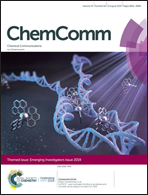aza-BODIPY synthesis towards vis/NIR functional chromophores based on a Schiff base forming reaction protocol using lactams and heteroaromatic amines
Abstract
aza-BODIPY is a class of heteroatom-containing BODIPY analogues targeting near infrared (NIR) chromophores and fluorophores. As a synthetic strategy towards aza-BODIPY structures, we have, recently, developed a Schiff base forming reaction using readily available lactams and heteroaromatic amines. Absorption and fluorescence of a series of compounds cover the whole range of the ultraviolet (UV)/visible (vis)/NIR regions. In addition, some compounds exhibit solid state emission, aggregation-induced emission enhancement, tunable fluorescence in the vis/NIR regions and non-linear optical properties. Furthermore, simple dimerization of aza-BODIPY chromophores caused unusual panchromatic absorption, whereas in combination with an N-confused porphyrin skeleton, multi-state NH tautomerism was achieved. In this Feature Article, wide applicability of this Schiff base forming reaction and optical and electrochemical properties of aza-BODIPY analogues thus synthesized are summarized including recent applications, such as bioimaging, photothermal cancer therapy and organic photovoltaics.

- This article is part of the themed collection: 2019 Emerging Investigators


 Please wait while we load your content...
Please wait while we load your content...